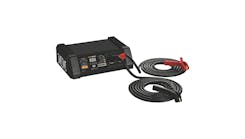Editor's Note: This article has been updated from its original 2012 version.
Thinking back over the years, my first encounter with fuel trim information was the General Motors block learn and integrator. My impression of this data was, “It is meaningless.” I think this opinion was formed from lack of information and lack of training. About 10 years ago, I was introduced to fuel trim data, and the power of the scan tool.
Before I start this discussion, I want to go over a little of the theory of fuel trim, where it comes from, what is it doing, and what it will tell us as we graph out the data on the scan tool. While I am talking about scan tools, I do recommend you use a scan tool that will graph the information since the trend of the data can be as important as the numbers as we troubleshoot drivability problems. It has been said that a picture is worth a thousand words, and in this case, that saying has never been truer. Another benefit of graphing data is you have a record of the broken vehicle, and you are also able to use the same test data to verify the problem was fixed properly.
The main object of fuel control is to control the air/fuel ratio so the engine will run smooth, efficient and produce good power all while producing a clean flow of exhaust gasses. To accomplish this small feat, the fuel control system will use sensors like engine coolant temperature, intake air temperature, throttle position, manifold absolute pressure, mass air flow and lambda sensors in the exhaust. All of these sensors input the data into the Engine Control Module (ECM), which processes the data and in turn operates the fuel injectors.
To be able to calculate the air/fuel ratio, the ECM needs a starting place. Since the gasoline engine is an air pump, it’s easiest to start with the calculation of the air mass. There are two different methods used today:
- The mass air flow method
- The speed density method
The first method is quite simple. The Mass Air Flow (MAF) sensor measures the weight of the air entering the engine, and the ECM controls the fuel injectors to achieve the correct air/fuel ratio. The speed density method is a little more complicated. It uses a manifold absolute pressure sensor, engine volume, and throttle position to calculate the weight of the air flow into the engine. Things like restricted air intakes, restricted exhaust, and EGR flow will not affect the air/fuel ratio.
The EGR acts as cylinder filler, and the air that is entering the engine has the proper amount of fuel injected to keep the air/fuel ratio correct. However, air leaks that happen any place between the engine side of the MAF and the intake valves will cause the system to run lean. This is because the air leak is allowing air to enter the engine without being first measured by the MAF sensor (also referred to as “unmetered air”). The lambda sensor that is mounted in the exhaust stream will see this extra oxygen and cause a positive trend to the fuel trim.
The speed density system plays by some different rules. An air leak into the intake manifold will not cause any change in the air/fuel ratio since the air leak is seen by the ECM the same as opening the throttle blade a little. Because there is an exception to every rule, an air leak can cause a lean condition if it is at an intake runner very close to an intake valve. This will cause a very localized high pressure in the intake manifold, which the MAP sensor will not detect and that one cylinder can run lean.
A restricted air intake system will not cause the air/fuel ratio to change, because the restriction is seen the same as throttle position (that is, both result in reduced air flow to the engine). Things like a leaking EGR valve or a restricted exhaust will cause the air/fuel ratio to go rich because these two things will cause the manifold pressure to increase (manifold vacuum to rise), and the MAP sensor will sense a high engine load, and in turn, the ECM will allow more fuel to flow through the fuel injectors.
The who, what, why of fuel trim data
Short-term fuel trim (STFT) is the product of the feedback from the oxygen sensors. This is the real-time correction to the fuel injector pulse width that is commanded by the ECM. The long-term fuel trim (LTFT) is the accumulated data from the short-term trims. This is the historical record from the O2 sensor feedback. This long-term fuel trim information is stored in fuel trim cells, which are data files taken at different engine speeds and loads. These fuel trim cells are used, so the ECM can quickly find the needed information when the engine load is changed.
Many times we have heard that oxygen sensors sense oxygen. Well in a way they do, but in a way they don’t. Oxygen sensors will react to oxygen, but they also react to the other gasses that are in the exhaust system. Things like hydrogen and carbon will cause the oxygen sensor to react, and unburned hydrocarbon (unburned gasoline) will cause the oxygen sensor to react differently. Knowing this will allow you to use the fuel trim information to analyze things like misfires or dribbling injectors.
While I am talking about oxygen sensors, don’t forget about the post-cat oxygen sensor. From time to time, the PCM will use this sensor for fuel trim. This data is available on many scan tools and can be very useful when you are working on drivability problems. The use of the rear oxygen sensor for fuel trim started around 1988 on the Toyota Van wagon. If you ever get one of these in your bay, take a look and there will be an oxygen sensor behind the cat. This sensor was put back there to aid in keeping the catalytic converter healthy and happy.
Fuel trim analysis
Now that we have a background on how fuel trim works, it will be easy to apply the theory to the problem. We know that an engine needs fuel and air to make power. The air entering the engine is metered, the fuel injectors inject the fuel into the air stream, and the oxygen sensors give a feedback to the ECM, which makes it possible for the ECM to either increase or decrease the fuel injector pulse width to keep the air/fuel ratio correct, and the tail pipe emissions nice and clean.
I refer to this as the fuel control circle. This little dance goes on and on, over and over, as the engine runs. If we hook up a scan tool to the data link, it is possible to see this action/reaction taking place as the engine is put through different engine speeds and loads. Being able to graph this data out on a scan tool will help you to get a quick direction when a drivability problem occurs.
Before we get started trying to use scan data to fix a broken car, we need to know what is good. This is true with both scan data and when using a labscope for testing. If you only pull out the test equipment when you have a broken car, you are probably not going to be able to get much good out of the tools. You need to be practicing on cars that are not broken. This playtime might seem like a waste of time but consider how children learn. Many times they learn by playing and just letting their minds wander and be creative.
There are only six distinct Parameter Identifiers (PIDs) that will be used (though you may have more than one of each depending on engine design). These PIDs are engine rpm, throttle position, calculated engine load, loop status, short-term trim for both banks, long-term trim from both banks, and the oxygen sensor voltage for all oxygen sensors. Set your scan tool to record only these PIDs. On most scan tools, that will keep the data rate up faster and make the data graphs more useable.
When using this diagnostic system, think about the cause and effect of the data. You move the throttle (cause) you expect the engine rpm to increase (effect). With the throttle wide open, you expect to see the oxygen sensors show a rich condition, and the calculated load PID to increase. Watching this data and how the different PIDs relate to one another, and how the data trends is an easy and accurate way to get a direction on the problem at hand.
To get a good feel of how this data works, take some test drives on known good cars, using the same test drive route. Capture the data and save it. You’ll have a reference library of known good information. With this great resource, you will not only have some great study material, you’ll also have a place to go when you need some known good data. You’ll learn that different makes and models of vehicles react differently, you’ll see how the calculated loads react and how the long term and short term react to a wide open throttle.
The test drive should start with the engine at idle. Accelerate at wide open throttle to a speed of 60 mph if possible. You will need to go through at least one full throttle shift to see how things work at full engine speed, then steady cruise for a minute or so. With this data, you will be able to analyze the operation of the MAF, verify proper fuel supply to the injectors, test the operation of the oxygen sensors, check for proper air flow through both engine banks (dual bank engine), and check for any misfires. Isn’t that a lot of great information to be gathered in such a short time?!
Applying what you learn
Using scan data allows you to test the fuel/air management system in its own working conditions while watching how the different parts of the system react with each other. When setting a vehicle up for a test, make sure that all electrical accessories are turned off since we will want to see the engine at idle with no loads. If the vehicle has daytime running lights, turn them off if possible.
Let’s apply what we know so far to a 1999 Subaru Forester with a 2.5 engine, automatic transmission and 128,649 miles on the odometer. The customer complained that when setting at a stoplight, the engine would surge as if the gas pedal had been quickly pushed and released.
The check engine light is not on, and there are no codes stored in memory. The Subaru vehicles of this era used both the MAF method and the speed density method for fuel management. A visual inspection of the engine found this particular vehicle had a MAF sensor bolted to the air filter box.
The PIDs selected for this test are engine rpm, throttle position, calculated engine load, front oxygen sensor, mass air flow, and long-term and short-term fuel trim. The engine was idled for a few minutes, then the vehicle was backed out of the shop. While backing out of the shop, the engine surged like I had tapped the gas pedal hard and fast. I first thought the ECM had commanded the Idle Air Control (IAC) open. As I drove out of the parking lot, the engine surge happened again. The scan tool was capturing data, so I continued on my test drive.
My test route takes me about a quarter of a mile before I am on a four-lane highway where I can make a full throttle acceleration up to 60 mph. This is done to be able to test the volumetric efficiency of the engine and to test for proper fuel supply to the fuel injectors. The test drive continues up a four percent grade ,then across one-quarter mile of flat road. With these different driving conditions, the engine can be put in several different power and load conditions while capturing the data.
On the test drive, I noticed the engine was short on power and would surge lightly if the throttle was held steady. Back at the shop, we can use this data to analyze the airflow and fuel systems of this engine. Starting at the left side of the data graphs, I noticed the engine is idling at 1,000 rpm. This is a little higher than normal, and it is a clue to our problem.
The MAF data looks a little higher than it should be. A rule of thumb on a MAF’s air flow rate at 500 rpm is one gram per second per liter of engine displacement. This engine is idling at 1,000 rpm, and the MAF data is showing 12.5 grams per second. Consider this to be another clue to our problem.
Moving on, I see the oxygen sensor voltage at 900 millivolts (0.900V), and both the long term and short term fuel trims at zero percent correction. At this point, I have made one mistake: I have not included the loop PID in my scan data, so I do not know if the engine is idling in open loop or not.
I can only guess it is running in open loop at idle. I also notice that the engine speed momentarily has increased, the MAF data has increased, and the engine load has shown a slight increase, but the throttle has not been opened. This is a third clue to the problem.
As the throttle is opened, the engine speed increases and the engine load increases while the long-term fuel trim has taken a big dive. As the throttle is moved, and the engine load changes, the long-term fuel trim will jump from zero to a -24 percent. The short-term fuel trim, though is moving up and down as the throttle is moved.
When the engine was at full throttle, the oxygen sensor was pegged high at 900 millivolts (0.900V), but the oxygen sensor voltage does not move up and down smoothly between 200 and 800 millivolts (0.200 and 0.800V) with the vehicle at cruise. Is this oxygen sensor getting lazy? This is the fourth clue to the problem.
Looking the engine load data over, I noticed that it peaked out at 90 percent load. Consider this as the fifth clue.
Now it is time to put all of the clues together and settle this mystery. Lets start with the data at idle when the engine speed flared slightly.
This was caused by the MAF misreporting airflow that triggered the ECM to momentarily give the fuel injectors an extra pulse or two of fuel. The MAF was actually over-reporting the air entering the engine. The ECM commanded the fuel injectors to inject the correct amount of fuel for the air the MAF was reporting, yet the reported air was more than what really entered the engine. That caused too much fuel for the actual amount of air and resulted in the 900 millivolt (0.900V) at the oxygen sensor.
If you study the long term and short-term fuel trims, you will notice that most times, the total fuel trim is -29 percent. Sometimes, this is shown in long term, and sometimes it is in short term.
Pay close attention to the way the fuel trim graphs trend from low to high. I call this trend “digital,” because the movement from -29 percent to zero percent is almost vertical, and the short term is also following the throttle movement. Here is a case where the information found in the trend of the fuel trims is of great value.
The last PID to examine is the load PID. The scan tool has recorded 90 percent engine load. This load PID is calculated from the MAF data and is a very good indication of the volumetric efficiency of the engine. Here is yet another clue to the mystery. It has been my experience that a known good Subaru load PID will display 100 percent at WOT and a shift point. Ninety percent is a good number for many vehicles but not for this one.
Solving the problem
We installed a new MAF sensor, reset the keep-alive memory, and cleared the computer of any codes that might have been set during the diagnostic process. We test drove the vehicle a few miles to allow the fuel trim memory to relearn, and then hooked up the scan tool to record after the repair test data.
The engine idle speed is now 675 rpm with 3 grams per second of air flow. This is the expected data. The engine speed flare is gone as the vehicle is backed out of the shop, and the slight engine speed fluctuation is gone at a steady cruise.
The long-term and short-term fuel trims trend nice and smooth between -2 and 8 long term and -8 and 7 short term. The oxygen sensor has gone back to swinging smoothly between 200 and 800 millivolts (0.200 and 0.800V), and the calculated engine load PID went to 100 percent at the WOT shift point. Examining the oxygen sensor data shows that on the WOT run, the voltage was pegged above 900 millivolts, which tells me that there is a good fuel supply to the fuel injectors.
Fuel trim data graphs hold a wealth of information about what is happening with air measurement, fuel supply, engine breathing, cam timing and even misfire problems. The data is quick and easy to get and over the years I have found it is a quick, easy, and accurate way to get a direction on engine drivability problems.
It also can be used as a great tool to sell service, so start graphing fuel trim data on every car you service, and you too will soon be using it to fix those stubborn drivability problems.



